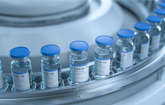
2026 Best Places for Pharmaceutical Manufacturing Insights Report highlights factors driving investment across a key industry in the "Reindustrialize America" movement
Raleigh, Salt Lake City ranked as top U.S. metro regions with the strongest combination of quality factors critical to therapeutic biologics manufacturing and competitive operating costs
GREENVILLE, S.C., Oct. 30, 2025 /PRNewswire/ -- Global Location Strategies (GLS), one of the world's leading corporate site selection firms, today unveiled its 2026 Best Places for Pharmaceutical Manufacturing Insights Report. The report identifies the key factors impacting investment in the U.S. therapeutic biologics industry, which comprises a specialized group of medicines made from living cells or organisms that can treat conditions that were once very difficult to manage, such as cancers, autoimmune disorders, and rare genetic diseases. The findings reveal that a current $350 billion investment boom is being constrained not by cost, but by talent. Skilled labor shortages are the most decisive factor shaping industry investment, followed by tariffs and policy shifts.
As the United States continues to focus on domestic reindustrialization, a strong domestic pharmaceutical manufacturing base is essential to national defense as it ensures secure access to critical medicines, vaccines, and biologics needed for military readiness and emergency response. By reducing reliance on foreign supply chains, the U.S. protects itself against geopolitical disruption, biothreats, and the weaponization of essential drug supplies.
The report also outlines the most competitive U.S. metropolitan regions for pharmaceutical manufacturing investment, and ranks the top 10 U.S. metropolitan areas offering the strongest combination of quality and cost factors critical to the industry. Raleigh, North Carolina and Salt Lake City, Utah earned the top two spots of all 387 U.S. regions, respectively.
"The amount of investment across the U.S. biologics industry is encouraging to see, but it's only sustainable if we invest as much in people as we do in plants," said Didi Caldwell, President and CEO, Global Location Strategies. "Workforce readiness is now the true competitive edge. Our ability to respond to skilled labor shortages will determine where investment goes from here. Building where the talent pool meets innovation and resilience is how the U.S. will continue to thrive."
The global biologics market is projected to grow 10.5% annually (2025–2035), outpacing traditional pharmaceuticals (8.7%). The U.S. remains the world's largest biologics market (48% of global revenues). Therapeutic biologics, such as monoclonal antibodies, recombinant proteins, gene and cell therapies, and therapeutic vaccines, represent the fastest-growing segment of global medicine, transforming treatment for cancer, autoimmune disease, and rare genetic disorders.
Industry Highlights
Manufacturing in the biologics sector surged during 2020–2021 as companies raced to produce COVID-19 vaccines through "at-risk" investments, then cooled to pre-pandemic levels that now form a stable baseline for ongoing production. Meanwhile, research and development activity has stayed elevated since 2021, a strong signal for future expansion as R&D pipelines typically precede new facility growth.
The U.S. remains the global anchor of biologics manufacturing, accounting for 90% of the 6,000 FDA-registered facilities worldwide.
Trade flows remain balanced at roughly $48 billion in imports and $49 billion in exports, yet 91% of biologics sold domestically are imported, revealing a paradox: America manufactures heavily but exports much of it, underscoring the sector's deep global interdependence even amid a push for on-shore resilience.
The U.S. is experiencing one of the largest biopharma investment waves in decades, with more than $350 billion in announced spending by 2030 across manufacturing, research and development, and supply chain functions. This is fueled by reshoring policies, tariff shifts, and strategic national security priorities. Among the key investments are Eli Lilly (Goochland County, VA; $5B; 650 jobs); AstraZeneca (Albemarle County, VA; $4.5B; 600 jobs); Biogen (Durham, NC; $2B; 2,415 jobs); Johnson & Johnson (NC; $2B; 120 jobs); and Merck & Co (Wilmington, DE; $1BN, 500 jobs).
The United States now ranks second globally for new biologics investment, trailing only Europe, which captured an average of 45% of new projects over the past decade. Japan, Germany, and Switzerland remain top foreign investors in U.S. therapeutic biologics.
Policy Shifts and Tariff Repercussions
The report highlights a new 100% tariff on branded and patented drug imports, effective October 2025, designed to incentivize domestic production.
- The policy has already triggered new long-term investments from AstraZeneca ($50B), Johnson & Johnson ($55B), GSK ($30B), and Eli Lilly ($11.5B).
- Exemptions exist for companies making substantial U.S. manufacturing investments.
These shifts, combined with rising FDA scrutiny of foreign plants, (only 6% of overseas facilities were inspected in 2022) are pushing multinational firms to bring manufacturing closer to U.S. soil.
Pricing pressure is also intensifying: branded drugs account for just 7% of prescriptions, but 87% of total drug spending, prompting policymakers to link reshoring with cost stabilization.
Workforce and Immigration Pressures
The industry employs roughly 46,000 workers, expanding 5.1% annually, far outpacing overall manufacturing. Yet a nationwide 8% vacancy rate leaves nearly 60,000 positions unfilled, concentrated in GMP operations and process validation.
Average wages have climbed nearly 10% in five years to $127,000, reflecting intense competition for specialized talent. At the same time, escalating H-1B visa costs and restrictions have slowed the inflow of international expertise, tightening an already scarce labor market and influencing where new facilities can viably take root.
To sustain growth, GLS suggests a dual-track workforce strategy, expanding domestic training while reopening targeted visa pathways for specialized international talent. The report urges state and regional partners to scale bioprocessing and GMP programs, build apprenticeships, and strengthen university-industry pipelines that lead directly to employment.
This two-pronged approach is essential for site selectors and investors looking to ensure that the U.S. biologics boom remains both scalable and sustainable.
Top 5 Metro Areas for Therapeutic Biologics Manufacturing
While legacy clusters such as New York, Boston and San Diego remain strong anchors, GLS research revealed that the following five markets offer the optimal blend of quality factors critical to therapeutic biologics manufacturing and competitive operating costs, aligning with the priorities of a company seeking to establish a large-scale, reliable commercial manufacturing site for a new therapeutic biologic.
- Raleigh-Cary, NC
- Salt Lake City–Murray, UT
- Durham–Chapel Hill, NC
- Philadelphia–Camden–Wilmington, PA–NJ–DE–MD
- Indianapolis–Carmel–Greenwood, IN
GLS identified Cincinnati, OH and St. Louis, MO as fast-rising contenders due to affordable industrial land and expanding talent pipelines.
The report positions U.S. biologics as a strategic national asset, vital to both public health and economic independence.
For more information or to access the full report, visit Global Location Strategies at https://globallocationstrategies.com/insights/#reports.
About Global Location Strategies
Founded in 2008, Global Location Strategies (GLS) is an internationally recognized leader in site selection, location strategy, and incentive negotiation for industrial and advanced manufacturing projects. With clients in aerospace, life sciences, metals, and logistics, GLS combines data-driven analysis with deep industry expertise to help companies choose locations that balance innovation, risk, and cost.
For more information, visit www.globallocationstrategies.com.
Media Contacts:
Scott Merritt
Strategic Global Media
E: [email protected]
M: 770-778-4786
Dwain Schenck
Strategic Global Media
E: [email protected]
M: 203-223-5230
SOURCE Global Location Strategies








Share this article